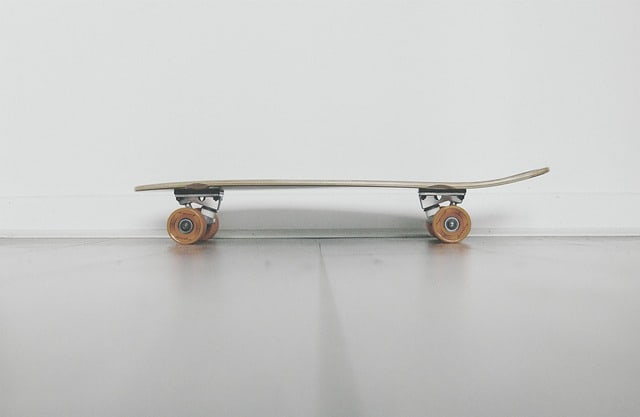A skateboard deck, which is the main part of a skateboard, is typically made from multiple layers of wood pressed together to create a strong and durable platform for riding. The most common type of wood used for skateboard decks is maple wood, specifically hard rock maple.
Maple wood is preferred for skateboard decks due to its excellent strength-to-weight ratio, which provides a balance of durability and lightness. The deck is usually constructed from 7 to 9 thin layers of maple veneer that are glued and pressed together using a process called lamination.
The individual layers of maple veneer are oriented in a way that maximizes the deck’s strength and flexibility. Skateboard decks can have different shapes, sizes, and concave profiles, catering to various riding styles and preferences of skateboarders.
While maple wood is the primary material used for skateboard decks, there are also alternative materials available in the market. Some companies offer decks made from bamboo, fiberglass, carbon fiber, or a combination of these materials, which can offer different performance characteristics and aesthetics.
However, maple wood remains the most popular and widely used material for skateboard decks due to its proven performance and reliability.
Skateboard Deck Materials Compared
Below is a table comparing different materials used for skateboard decks:
| Material | Characteristics | Pros | Cons |
|---|---|---|---|
| Maple Wood | – Excellent strength-to-weight ratio | – Durable and long-lasting | – Heavier compared to some alternative materials |
| – Proven performance and reliability | – Provides good pop for tricks | – Limited design options for natural wood | |
| – Good flexibility for smooth riding | – Affordable and widely available | ||
| Bamboo | – Sustainable and eco-friendly grass with wood-like qualities | – Lightweight and flexible | – May be more expensive than maple wood |
| – Offers a unique natural aesthetic | – Eco-friendly choice | – Durability may vary based on quality | |
| Fiberglass | – High strength and rigidity | – Provides excellent pop for tricks | – Can be expensive compared to wood decks |
| – Lighter weight compared to traditional wood | – Can be designed with unique shapes | – Less common, limited availability | |
| – Excellent impact resistance and durability | – Great for freestyle and street skateboarding | ||
| Carbon Fiber | – Extremely lightweight and strong | – Provides maximum pop and responsiveness | – Very expensive, not commonly used |
| – High stiffness for precise control and stability | – Suitable for advanced and professional skaters | – Limited availability | |
| – Offers a modern and sleek appearance | – Minimalistic design possibilities | ||
| Hybrid (e.g., Maple/Bamboo | – Combines multiple materials for optimized performance | – Customizable features and characteristics | – May have higher cost |
| – Can offer a balance of strength, flexibility, and weight | – Tailored to specific riding styles | – Durability may vary based on construction | |
| – Enhanced pop and responsiveness | – Ideal for riders seeking specialized decks |
Each material has its unique characteristics, and the choice of skateboard deck material depends on the rider’s preferences, riding style, and budget. Maple wood remains the most popular and widely used material due to its proven performance and affordability.
However, alternative materials like bamboo, fiberglass, carbon fiber, and hybrid constructions offer additional options for skateboarders seeking specific performance attributes and aesthetics.

Typical Skateboard Specifications
The typical weight, size, and dimensions of a skateboard can vary based on the rider’s preferences and the intended use of the skateboard.
However, there are some common standards and ranges for skateboard specifications:
- Weight: The weight of a standard skateboard deck made from maple wood is typically around 2.5 to 3.5 pounds (1.1 to 1.6 kilograms). The overall weight of a complete skateboard, including trucks, wheels, and bearings, can range from 4 to 6 pounds (1.8 to 2.7 kilograms).
- Size: Skateboard decks come in various sizes, with the width being the most important measurement. The most common skateboard deck widths range from 7.5 to 8.5 inches (19 to 21.6 centimeters). For younger or smaller riders, narrower decks in the range of 7.0 to 7.25 inches (17.8 to 18.4 centimeters) are also available.
Additionally, skateboard decks typically have a length ranging from 28 to 32 inches (71 to 81 centimeters). - Dimensions: The typical dimensions of a standard skateboard deck are around 7.75 inches (19.7 centimeters) in width and 31.25 inches (79.4 centimeters) in length.
However, as mentioned earlier, these dimensions can vary depending on the rider’s preferences and the specific style of skateboarding they enjoy.
It’s essential for skateboarders to choose a deck size that matches their skill level, riding style, and body size. Smaller decks are generally more maneuverable and suitable for technical tricks, while larger decks provide more stability and are preferred for cruising and vert skateboarding.
Remember that these are general guidelines, and some riders may prefer skateboards outside of the typical ranges. Ultimately, the right skateboard size and dimensions depend on the individual’s comfort and riding style. It’s always a good idea to try out different sizes and styles to find the one that suits you best.
Click here to view a post called How to Care for Your Wood Skateboard Deck: Maintenance Tips and Tricks which among other things suggests how to maintain your skateboard with wood finishing.

